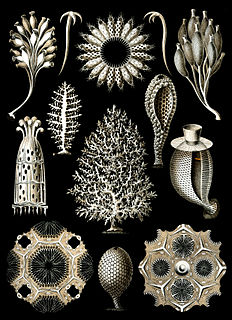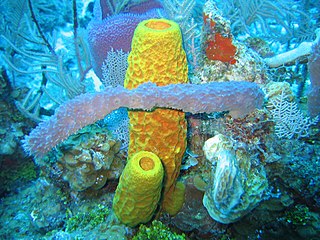
The calcareous sponges of class Calcarea are members of the animal phylum Porifera, the cellular sponges. They are characterized by spicules made out of calcium carbonate in the form of calcite or aragonite. While the spicules in most species have three points, in some species they have either two or four points.

Leucosolenida is an order of sponges in the class Calcarea. Species in the order Leucosolenida are calcareous with a skeleton composed exclusively of free spicules without calcified non-spicular reinforcements.

Demospongiae is the most diverse class in the phylum Porifera. They include 76.2% of all species of sponges with nearly 8,800 species worldwide. They are sponges with a soft body that covers a hard, often massive skeleton made of calcium carbonate, either aragonite or calcite. They are predominantly leuconoid in structure. Their "skeletons" are made of spicules consisting of fibers of the protein spongin, the mineral silica, or both. Where spicules of silica are present, they have a different shape from those in the otherwise similar glass sponges.

Agelas clathrodes, also known as the orange elephant ear sponge, is a species of sea sponge. It lives on reefs in the Caribbean, usually more than 10 metres (33 ft) below the surface of the ocean. It takes various forms, and its color is reddish orange.

Homoscleromorpha is a class of marine sponges composed of two families: Plakinidae and Oscarellidae.

Xestospongia testudinaria is a species of barrel sponge in the family Petrosiidae.
The genus name Aaata has been described as a synonym to two species in the Microcionidae family of sea sponges (Demospongiae). The two species being:
Pseudospongosorites suberitoides is a species of demosponge belonging to the family Suberitidae. It is currently considered the only species in the genus Pseudospongosorites. It is found in the Caribbean Sea, the Gulf of Mexico and on the Atlantic coast of the United States as far north as North Carolina. This species is known by the common name Florida hermit crab sponge, so named because hermit crabs often use it as shelter.

Poecilosclerida is an order of the demosponge class. It is the most speciose demosponge order with over 2200 species. It contains about 25 recognised families. They are characterised by having chelae microscleres, that is, the minute spicules scattered through the tissues, usually in the 10-60 µm range, have a shovel-like structure on the end.

Dictyoceratida is an order of sponges in the subclass Ceractinomorpha containing five families. Along with the Dendroceratida, it is one of the two orders of demosponges that make up the keratose or "horny" sponges, in which a mineral skeleton is minimal or absent and a skeleton of organic fibers containing spongin, a collagen-like material, is present instead.
Céline Allewaert is a Belgian spongiologist who works at Ghent University.

Verongimorpha is the name of a subclass of sea sponges within the phylum Porifera. It was first authenticated and described by Erpenbeck et al. in 2012.

Aplysinidae is a family of sea sponges in the order Verongiida. Its growths are either shaped like a fan or a club. Contained within the family are three recognized genera and six unrecognized ones. It was first authenticated and described by Carter in 1875.

Thorectidae is a family of sea sponges in the order Dictyoceratida.

Agelasida is an order of sea sponges in the class Demospongiae.

Heteroscleromorpha is a subclass of demosponges within the phylum Porifera.
Spongillida is an order of sea sponges in the subclass Heteroscleromorpha.
Citronia is a genus of sea sponges in the family Dysideidae. It consists of one species, Citronia vasiformis(Bergquist, 1995).
Aplysina fistularis is a species of sea sponge in the order Verongiida.
Ernstilla is a genus of sponges, marine organisms that lived attached to the sea floor. The genus emerged from an examination of species named as Dendrilla lacunosa by Ernst Hentschel in 1912, describing specimens collected in Indonesia and later discovered at the Kimberley and nortwest coast of Australia. The Western Australian researcher Jane Fromont observed that the form of the species, long and whip-like, resembled other classifications and not the small delicate structure of other Dendrilla species. The initial examination required international research to complete, and the result was the identification of a new genus and family, allied to the Verongiida order. The study discovered that while resembling the morphology of the former classification, the skeletal structure of the species was suspected and confirmed to contain chitin.












